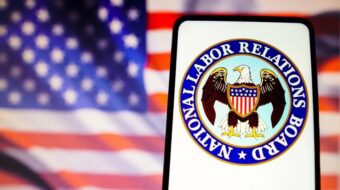WASHINGTON – The United States is dead last among 21 top developed nations in both unionization rates and union coverage of the workforce, a new study says – and it’s not because of globalization or high technology.
Instead, according to “Politics Matter: Changes in Unionization Rates in Rich Countries, 1960-2010,” national political climates – which can expand legal rules such as who labor law covers, whom unions can bargain for and represent, and how free unions are to organize – are the determining factors in both union coverage and union density.
Countries with a Social Democratic political climate had consistently high rates of both unionization and union coverage. Countries with a “Continental European” tradition, where union membership is less enshrined, but collective bargaining coverage of workers is strong, have high union coverage rates but declining union membership.
And so-called “liberal market” economies like the U.S. and Britain, that, at best, are neutral about both organizing and union membership saw both membership and coverage crash, the Center for Economic Policy and Research study reported.
The biggest membership decline was in New Zealand, down 47.7 percentage points since 1980, the first year figures are available for all 21 nations. And while U.S. union membership dropped by 12.4 percentage points since 1980, it started from a lower base than the other 20 nations, and rested at 13.3 percent in 2007, dead last. Overall, union density rose in only one country, Finland (+0.9 percent), and coverage rose in five.
“Researchers have offered many explanations for the decline in unionization,” the report says. “Some suggest that the demand for union representation has fallen. Most, however, argue that, for various reasons, the supply of union jobs has decreased.
“Some researchers blame” union leaders for focusing on “servicing existing members rather than organizing new members. Others emphasize weak legal protections for the right to organize, in combination with heightened employer opposition beginning in the early 1980s. But, probably the most common argument, at least in the public discussion, is the idea that unions are incompatible with the emerging, increasingly globalized, high-tech, service economy.
“If the decline in unionization is the inevitable response to the twin forces of globalization and technology, we would expect unionization rates to follow a similar path in other countries subjected to roughly similar levels of globalization and technology,”
But the unionization rates didn’t follow those patterns, researchers said.
“These differences across countries exposed to broadly similar levels of globalization and technological change suggest that neither factor mechanically determines national levels of unionization.
“One simple factor, however, does appear to explain much of the observed variation in unionization trends: The broad national political environment. Countries that have been strongly identified during the postwar period with social democratic parties – Sweden, Denmark, Norway, and Finland – have generally seen small increases in union coverage and only small decreases in union membership since 1980.
“Over the same period, countries identified as ‘liberal market economies’ – the United States, the United Kingdom, Australia, New Zealand, Ireland, Canada, and Japan – have generally seen sharp drops in union coverage and membership.”
The findings have implications for the U.S. union movement: The AFL-CIO made passage of the Employee Free Choice Act a top legislative priority, to help level the playing field in both organizing and bargaining. But both labor and the law were sidetracked by having to fight a concerted attack on union rights by the Republican Party and its allies. A planned Senate GOP filibuster killed the EFCA even before republicans took over the House in 2010.
One chart in the report shows that after the mid-1950s, U.S. private-sector unionization rates declined, with a steep fall starting after the Reagan administration began. But unionization among public sector workers hovered around 15 percent from 1948, the first year data is available, through 1962-63. It leaped 10 percentage points in one year and has risen since then to close to 40 percent.
While the report did not say so, public sector labor laws have generally been more neutral and less hostile to organizing than the National Labor Relations Act, as rewritten by the GOP-run Congress in the 1947 Taft-Hartley Act. Labor law covering government workers, however, also often bans strikes and orders mandatory arbitration.
“National political traditions established in the period 1946 through 1980 have a strong capacity to predict changes in unionization rates from 1980 to the present. Of course, our analysis cannot establish causality, but the data are consistent with the view that national politics are a major determinant of national unionization rates and changes in those rates in recent decades. At the same time, the data contradict the view that a decline in unionization rates is an inevitable implication of ‘globalization’ or technological change,” the report’s authors conclude.
The entire report is available from the Center for Economic Policy and Research.










